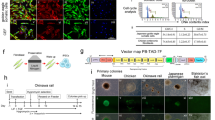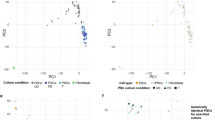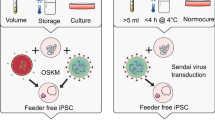Abstract
Reprogramming of somatic cells in the enucleated egg made Dolly, the sheep, the first successfully cloned mammal in 1996. However, the mechanism of sheep somatic cell reprogramming has not yet been addressed. Moreover, sheep embryonic stem (ES) cells are still not available, which limits the generation of precise gene-modified sheep. In this study, we report that sheep somatic cells can be directly reprogrammed to induced pluripotent stem (iPS) cells using defined factors (Oct4, Sox2, c-Myc, Klf4, Nanog, Lin28, SV40 large T and hTERT). Our observations indicated that somatic cells from sheep are more difficult to reprogram than somatic cells from other species, in which iPS cells have been reported. We demonstrated that sheep iPS cells express ES cell markers, including alkaline phosphatase, Oct4, Nanog, Sox2, Rex1, stage-specific embryonic antigen-1, TRA-1-60, TRA-1-81 and E-cadherin. Sheep iPS cells exhibited normal karyotypes and were able to differentiate into all three germ layers both in vitro and in teratomas. Our study may help to reveal the mechanism of somatic cell reprogramming in sheep and provide a platform to explore the culture conditions for sheep ES cells. Moreover, sheep iPS cells may be directly used to generate precise gene-modified sheep.
Similar content being viewed by others
Log in or create a free account to read this content
Gain free access to this article, as well as selected content from this journal and more on nature.com
or
References
Campbell KH, McWhir J, Ritchie WA, Wilmut I . Sheep cloned by nuclear transfer from a cultured cell line. Nature 1996; 380:64–66.
Damak S, Jay NP, Barrell GK, Bullock DW . Targeting gene expression to the wool follicle in transgenic sheep. Biotechnology (NY) 1996; 14:181–184.
Damak S, Su H, Jay NP, Bullock DW . Improved wool production in transgenic sheep expressing insulin-like growth factor 1. Biotechnology (NY) 1996; 14:185–188.
Wall RJ, Rexroad CE, Jr, Powell A, et al. Synthesis and secretion of the mouse whey acidic protein in transgenic sheep. Transgenic Res 1996; 5:67–72.
Evans MJ, Kaufman MH . Establishment in culture of pluripotential cells from mouse embryos. Nature 1981; 292:154–156.
Thomas KR, Capecchi MR . Site-directed mutagenesis by gene targeting in mouse embryo-derived stem cells. Cell 1987; 51:503–512.
Capecchi MR . Altering the genome by homologous recombination. Science 1989; 244:1288–1292.
Martin GR . Isolation of a pluripotent cell line from early mouse embryos cultured in medium conditioned by teratocarcinoma stem cells. Proc Natl Acad Sci USA 1981; 78:7634–7638.
Thomson JA, Itskovitz-Eldor J, Shapiro SS, et al. Embryonic stem cell lines derived from human blastocysts. Science 1998; 282:1145–1147.
Thomson JA, Kalishman J, Golos TG, et al. Isolation of a primate embryonic stem cell line. Proc Natl Acad Sci USA 1995; 92:7844–7848.
Buehr M, Meek S, Blair K, et al. Capture of authentic embryonic stem cells from rat blastocysts. Cell 2008; 135:1287–1298.
Li P, Tong C, Mehrian-Shai R, et al. Germline competent embryonic stem cells derived from rat blastocysts. Cell 2008; 135:1299–1310.
Takahashi K, Tanabe K, Ohnuki M, et al. Induction of pluripotent stem cells from adult human fibroblasts by defined factors. Cell 2007; 131:861–872.
Takahashi K, Yamanaka S . Induction of pluripotent stem cells from mouse embryonic and adult fibroblast cultures by defined factors. Cell 2006; 126:663–676.
Yu J, Vodyanik MA, Smuga-Otto K, et al. Induced pluripotent stem cell lines derived from human somatic cells. Science 2007; 318:1917–1920.
Hanna J, Wernig M, Markoulaki S, et al. Treatment of sickle cell anemia mouse model with iPS cells generated from autologous skin. Science 2007; 318:1920–1923.
Wernig M, Meissner A, Foreman R, et al. In vitro reprogramming of fibroblasts into a pluripotent ES-cell-like state. Nature 2007; 448:318–324.
Liao J, Cui C, Chen S, et al. Generation of induced pluripotent stem cell lines from adult rat cells. Cell Stem Cell 2009; 4:11–15.
Li W, Wei W, Zhu S, et al. Generation of rat and human induced pluripotent stem cells by combining genetic reprogramming and chemical inhibitors. Cell Stem Cell 2009; 4:16–19.
Wu Z, Chen J, Ren J, et al. Generation of pig induced pluripotent stem cells with a drug-inducible system. J Mol Cell Biol 2009; 1:46–54.
Esteban MA, Xu J, Yang J, et al. Generation of induced pluripotent stem cell lines from Tibetan miniature pig. J Biol Chem 2009; 284:17634–17640.
Ezashi T, Telugu BP, Alexenko AP, et al. Derivation of induced pluripotent stem cells from pig somatic cells. Proc Natl Acad Sci USA 2009; 106:10993–10998.
Park IH, Zhao R, West JA, et al. Reprogramming of human somatic cells to pluripotency with defined factors. Nature 2008; 451:141–146.
Mali P, Ye Z, Hommond HH, et al. Improved efficiency and pace of generating induced pluripotent stem cells from human adult and fetal fibroblasts. Stem Cells 2008; 26:1998–2005.
Chou YF, Chen HH, Eijpe M, et al. The growth factor environment defines distinct pluripotent ground states in novel blastocyst-derived stem cells. Cell 2008; 135:449–461.
Chen T, Yuan D, Wei B, et al. E-cadherin-mediated cell-cell contact is critical for induced pluripotent stem cell generation. Stem Cells 2010; 28:1315–1325.
Li R, Liang J, Ni S, et al. A mesenchymal-to-epithelial transition initiates and is required for the nuclear reprogramming of mouse fibroblasts. Cell Stem Cell; 7:51–63.
Aoi T, Yae K, Nakagawa M, et al. Generation of pluripotent stem cells from adult mouse liver and stomach cells. Science 2008; 321:699–702.
Zhao XY, Li W, Lv Z, et al. iPS cells produce viable mice through tetraploid complementation. Nature 2009; 461:86–90.
Kang L, Wang J, Zhang Y, Kou Z, Gao S . iPS cells can support full-term development of tetraploid blastocyst-complemented embryos. Cell Stem Cell 2009; 5:135–138.
Ahuja D, Saenz-Robles MT, Pipas JM . SV40 large T antigen targets multiple cellular pathways to elicit cellular transformation. Oncogene 2005; 24:7729–7745.
Cheng L, Kelly TJ . Transcriptional activator nuclear factor I stimulates the replication of SV40 minichromosomes in vivo and in vitro. Cell 1989; 59:541–551.
Erdile LF, Collins KL, Russo A, et al. Initiation of SV40 DNA replication: mechanism and control. Cold Spring Harb Symp Quant Biol 1991; 56:303–313.
Bocchetta M, Eliasz S, De Marco MA, et al. The SV40 large T antigen-p53 complexes bind and activate the insulin-like growth factor-I promoter stimulating cell growth. Cancer Res 2008; 68:1022–1029.
Hong H, Takahashi K, Ichisaka T, et al. Suppression of induced pluripotent stem cell generation by the p53-p21 pathway. Nature 2009; 460:1132–1135.
Kawamura T, Suzuki J, Wang YV, et al. Linking the p53 tumour suppressor pathway to somatic cell reprogramming. Nature 2009; 460:1140–1144.
Marion RM, Strati K, Li H, et al. A p53-mediated DNA damage response limits reprogramming to ensure iPS cell genomic integrity. Nature 2009; 460:1149–1153.
Utikal J, Polo JM, Stadtfeld M, et al. Immortalization eliminates a roadblock during cellular reprogramming into iPS cells. Nature 2009; 460:1145–1148.
Zhao Y, Yin X, Qin H, et al. Two supporting factors greatly improve the efficiency of human iPSC generation. Cell Stem Cell 2008; 3:475–479.
Bodnar AG, Ouellette M, Frolkis M, et al. Extension of life-span by introduction of telomerase into normal human cells. Science 1998; 279:349–352.
Kim DK . Estimating doubling time of cells in vitro. In Vitro Cell Dev Biol Anim 1995; 31:419–420.
Amit M, Carpenter MK, Inokuma MS, et al. Clonally derived human embryonic stem cell lines maintain pluripotency and proliferative potential for prolonged periods of culture. Dev Biol 2000; 227:271–278.
Xiao L, Yuan X, Sharkis SJ . Activin A maintains self-renewal and regulates fibroblast growth factor, Wnt, and bone morphogenic protein pathways in human embryonic stem cells. Stem Cells 2006; 24:1476–1486.
Acknowledgements
This research was partially supported by grants from the National Key Basic Research and Development Program of China (2007CB947902, 2007CB948003, 2009CB941101, 2009CB940903), the National Natural Science Foundation of China (30971682, 30901019, 31025016), the Ministry of Agriculture (2009ZX08010-016B), the National High Technology Research and Development Program (863 program) of China (2010AA100504) and the Chinese Academy of Sciences Knowledge Creation Program (KSCX2-YW-R-223).
Author information
Authors and Affiliations
Corresponding author
Additional information
( Supplementary information is linked to the online version of the paper on the Cell Research website.)
Supplementary information
Supplementary information, Figure S1
Immunostaining of OCT4, SOX2 and NANOG in sheep iPS cells. (PDF 57 kb)
Supplementary information, Table S1
Primers for RT-PCR (PDF 17 kb)
Supplementary information, Table S2
PCR primers for Bisulfite genomic sequencing (PDF 28 kb)
Rights and permissions
About this article
Cite this article
Bao, L., He, L., Chen, J. et al. Reprogramming of ovine adult fibroblasts to pluripotency via drug-inducible expression of defined factors. Cell Res 21, 600–608 (2011). https://doi.org/10.1038/cr.2011.6
Received:
Revised:
Accepted:
Published:
Issue date:
DOI: https://doi.org/10.1038/cr.2011.6
Keywords
This article is cited by
-
Establishment of Capra hircus somatic cells and induction of pluripotent stem-like cells
In Vitro Cellular & Developmental Biology - Animal (2024)
-
The impact of induced pluripotent stem cells in animal conservation
Veterinary Research Communications (2024)
-
The miR-302s/367 Cluster Inhibits the Proliferation and Apoptosis in Sheep Fetal Fibroblasts via the Cell Cycle and PI3K-Akt Pathways
Mammalian Genome (2021)
-
The use of induced pluripotent stem cells in domestic animals: a narrative review
BMC Veterinary Research (2020)
-
Generation of induced pluripotent stem cells from large domestic animals
Stem Cell Research & Therapy (2020)



